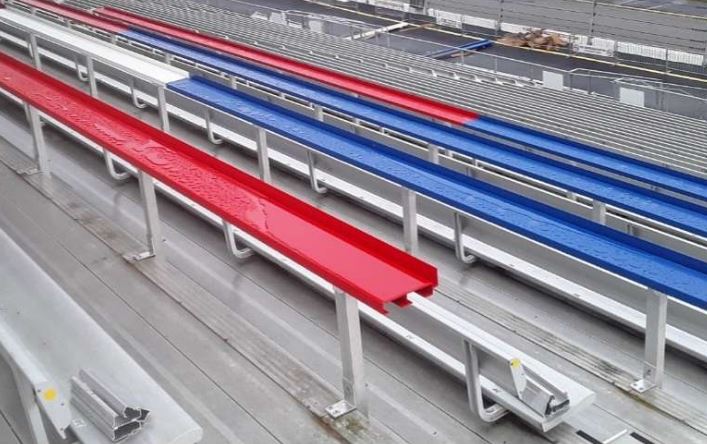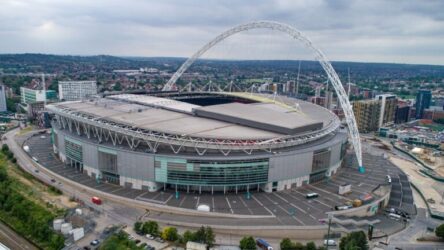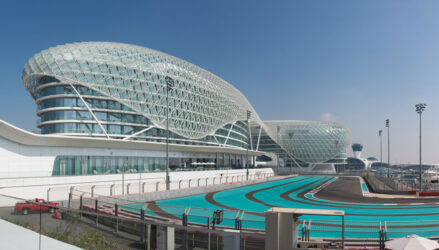Bleachers, Grandstands, and Everything in Between: A Must-Know Guide to Seating Terminology
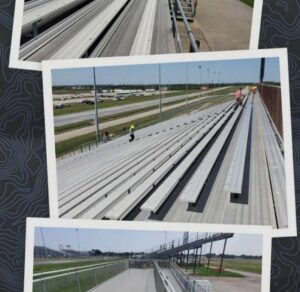 If you’ve ever tried selecting bleachers or grandstands for a school, park, or stadium, you’ve probably realized something quickly: there’s a
If you’ve ever tried selecting bleachers or grandstands for a school, park, or stadium, you’ve probably realized something quickly: there’s alot more to it than just picking a few rows of aluminum and calling it a day. Bleachers and grandstands come in all shapes, sizes, and styles.
The options can feel endless—and overwhelming. But here’s the good news: understanding some key terminology can make the process a whole lot easier.
So, let’s get into it.
Elevated vs. Non-Elevated Bleachers: What’s the Difference?
bleachers?
non-elevated bleacher. These are typically the go-to choice for lower-capacity venues or places that need portability, like high school
gymnasiums or community parks. They’re efficient, cost-effective, and easy to move when needed.
ground level, often protected by guardrails or fencing. These are great for maximizing sightlines in larger stadiums where spectators want an unobstructed view of the action.
Tip and Roll Bleachers: The Swiss Army Knife of Seating
home. Simple, right? They’re like the convertible couch of stadium seating—functional, compact, and easy to use.
Decoding Bleacher Jargon: A Quick List of Definitions
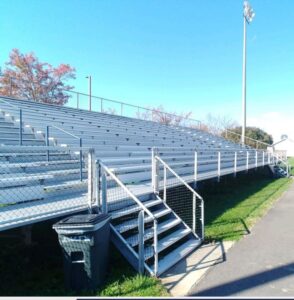 Now let’s talk about some of the more technical terminology you’re likely to come across when browsing through seating options. This
Now let’s talk about some of the more technical terminology you’re likely to come across when browsing through seating options. This
section could be the cheat sheet you never knew you needed.
- Grandstands: These are the big guys. Permanent structures, often found in stadiums, racetracks, or large-scale venues. Think NFL Sundays or NASCAR weekends.
- ADA Compliant: Accessibility isn’t just a buzzword; it’s the law. ADA-compliant seating ensures people of all abilities can safely
access and enjoy the facility. If your seating isn’t accessible, it’s not complete. - Galvanized Steel: Zinc-coated to inhibit rust formation. If you’re placing your bleachers outdoors, this is your armor against the
elements. - Deck Boards: These are the planks you actually sit on. Most modern bleachers use aluminum, but old-school wooden ones can often be retrofitted.
- Rise and Run: This duo defines the comfort and accessibility of your seating.
- “Rise” signifies the height between the bottom of the row to the top of the row, whereas “Run” indicates the depth of the seating
area. The perfect combo ensures spectators get a good view without feeling like they’re climbing Everest.
- “Rise” signifies the height between the bottom of the row to the top of the row, whereas “Run” indicates the depth of the seating
- I-Beam Structures: These offer flexibility and functionality. Large steel beams (shaped like an “I”) support the structure, allowing for usable space underneath—ideal for concessions or storage.
- Angle Frame Structures: More cost-effective than I-beams, these use interconnected bars to support the seating. They work best on level ground and are typically mounted to concrete.
Knowing these terms isn’t just about sounding smart in meetings. It empowers you to ask the right questions and avoid paying for features
you don’t need—or worse, missing ones you do.
Why Bleacher ADA Compliance Matters More Than Ever
If there’s one thing you shouldn’t overlook in your seating plan, it’s accessibility. Making your seating ADA compliant isn’t just a
feel-good move—it’s a smart, long-term investment.
Let’s break it down: ADA-compliant bleachers include features like ramps, reserved wheelchair areas, and railings that make stadiums safer
and more inclusive. Installing them upfront saves you from costly renovations when regulations evolve (and they will).
More importantly, it sends a message. It says that your venue welcomes everyone, regardless of physical ability. In a world that values
inclusivity more than ever, that message counts for a lot.
Want to know a great first step? Add an ADA accessible ramp. It’s a straightforward solution that opens your space to more people. And
let’s be honest—the last thing you want is a grandparent missing their grandkid’s big game because they couldn’t get to a seat.
Customizable Features: Your Seating, Your Rules
Here’s where things get fun. Bleachers and grandstands aren’t one-size-fits-all. In fact, the best solutions are tailor-made. Whether
you’re managing a high school football program or building a stadium for a professional team, customization allows you to align your seating with your exact needs.
Maybe you need extra-wide aisles for crowd flow, or maybe you want your school’s logo stamped into every seatback. From press boxes to safety railings, modern bleacher providers offer more custom options than ever before. Some even help with site measurement, product planning, and installation from day one.
Don’t settle. If you’re going to invest in something this big, make sure it reflects your facility’s unique needs. And if you’re also eyeing
upgrades like stadium lights or a track around your field, many providers can bundle those services too.
The Bottom Line: Smart Seating Starts With Smart Terminology
 There’s no shortage of options when it comes to bleachers, grandstands, and seating layouts. But here’s the thing: all the options
There’s no shortage of options when it comes to bleachers, grandstands, and seating layouts. But here’s the thing: all the options
in the world won’t help if you don’t speak the language. Understanding terms like “elevated,” “non-elevated,” “ADA compliant,” and “Tip and Roll” turns a daunting purchase into a strategic investment.
So the next time you walk into a meeting about upgrading your facility’s seating, you’ll do so with confidence. Contact us, Preferred Seating. You’ll ask better questions. You’ll get better answers. And most importantly, you’ll end up with a setup that makes sense for your space, your budget, and your audience.
After all, stadiums are more than just structures. They’re where memories are made. So why not make yours unforgettable?
Some of our stadium designs:
I-Beam Bleachers
Angle Frame Bleachers
Aluminum structures bleachers and more
3-4 row bleachers
Portable bleachers



